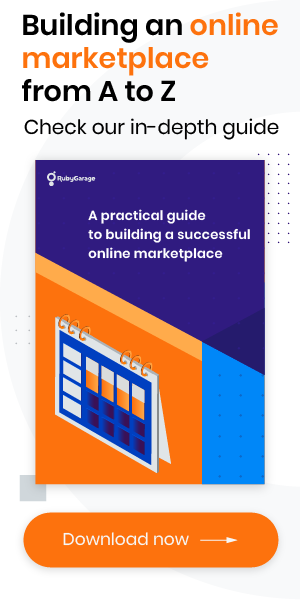-
Product Management
Software Testing
Technology Consulting
-
Multi-Vendor Marketplace
Online StoreCreate an online store with unique design and features at minimal cost using our MarketAge solutionCustom MarketplaceGet a unique, scalable, and cost-effective online marketplace with minimum time to marketTelemedicine SoftwareGet a cost-efficient, HIPAA-compliant telemedicine solution tailored to your facility's requirementsChat AppGet a customizable chat solution to connect users across multiple apps and platformsCustom Booking SystemImprove your business operations and expand to new markets with our appointment booking solutionVideo ConferencingAdjust our video conferencing solution for your business needsFor EnterpriseScale, automate, and improve business processes in your enterprise with our custom software solutionsFor StartupsTurn your startup ideas into viable, value-driven, and commercially successful software solutions -
-
- Case Studies
- Blog
Useful Tips on How to Create a Successful Crowdfunding Platform
Crowdfunding has changed the way startups and entrepreneurs find pre-seed and seed capital for their projects. As practice has shown, crowdfunding is not only an opportunity for creators and investors to bring innovations to life but is also a source of income for crowdfunding platform owners. In this post, we show you how to create a crowdfunding platform and start your own business in this sphere.
Is it worth it to create a crowdfunding platform?
First of all, let’s see how promising a crowdfunding business can be. Below, we present the most significant information you should know about the crowdfunding market.
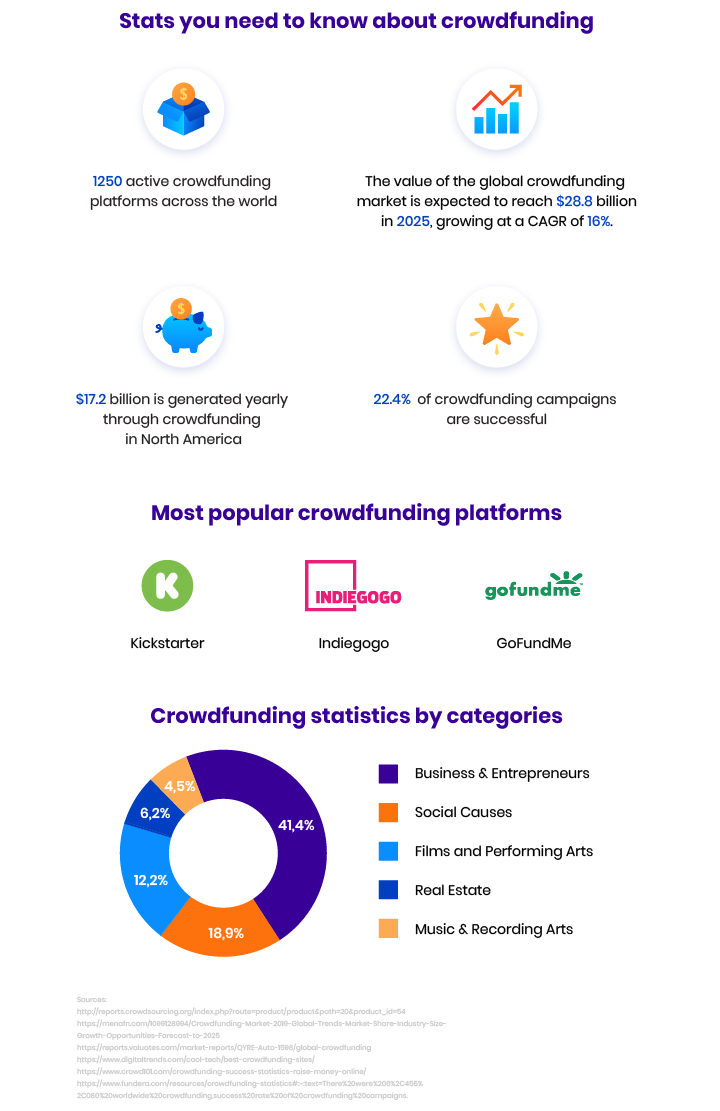
Best examples of crowdfunding platforms
To start a successful crowdfunding platform, you need to know who your direct competitors are. Let’s take a look at the most successful crowdfunding platforms.
Kickstarter
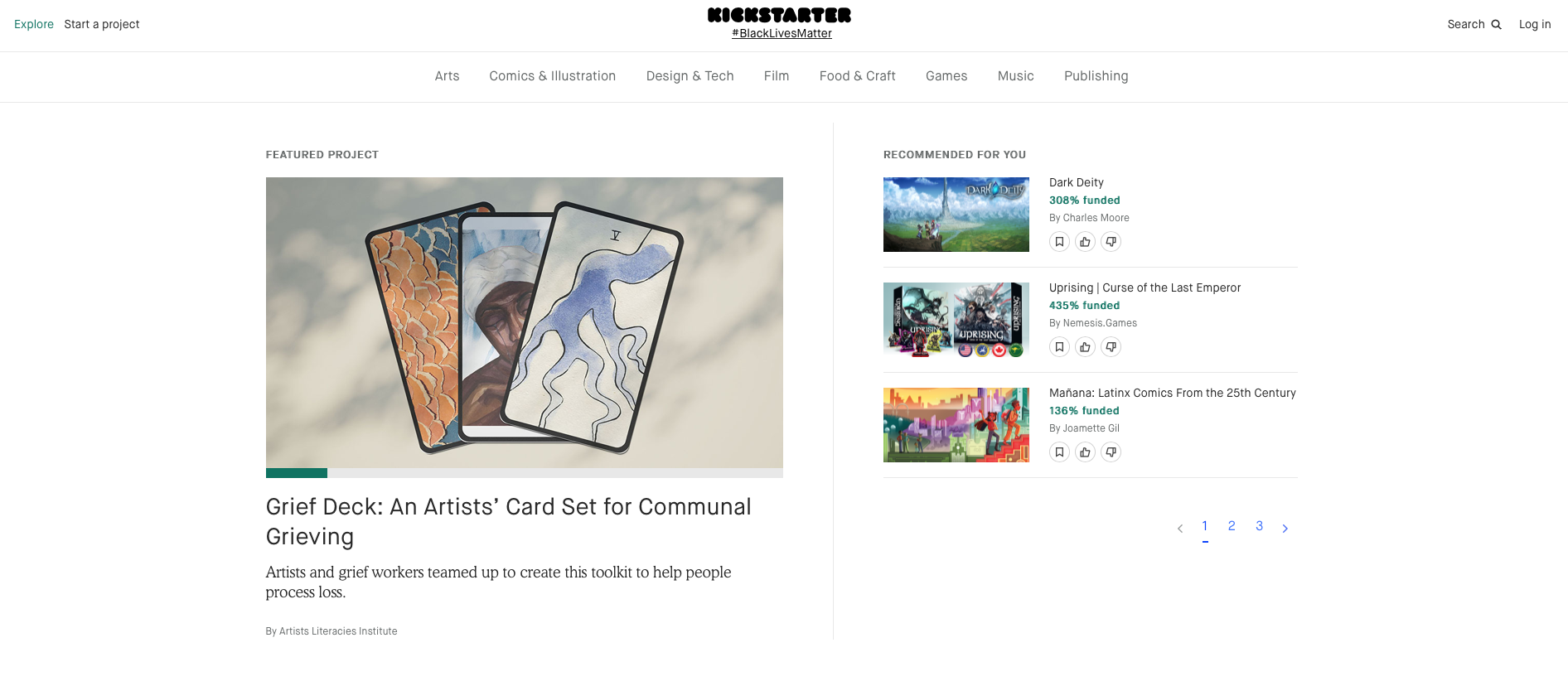
Kickstarter is the leading name in the crowdfunding market. The average success rate of Kickstarter campaigns is 37.92%. This platform helps entrepreneurs raise the funds required to launch their creative projects in 15 categories. The most popular categories on Kickstarter are Film & Video (75,140 launched projects), Music (82,894 launched projects), and Games (54,269 launched projects).
Kickstarter offers an all-or-nothing funding system. A project creator sets a goal and a deadline for fundraising. Once the goal is reached, those who have pledged to support the project are charged. If the project fails to reach the goal, no one is charged and the project creator receives no funding.
Indiegogo

Similarly to Kickstarter, Indiegogo allows startups, charities, and people with creative ideas to get financial support to launch their projects. However, in contrast to Kickstarter, Indiegogo allows for flexible campaigns so that creators can keep as much money as they manage to raise, even if they fail to reach the goal. Fixed campaigns (the equivalent of Kickstarter’s all-or-nothing campaigns) are also available on Indiegogo. The average success rate of all Indiegogo campaigns is 9.8%, while the average success rate of fixed funding campaigns on Indiegogo is 17.1%.
GoFundMe

GoFundMe is a platform that allows charities, companies, and individuals to fundraise money for any occasion. Since 2010, the platform has raised $9 billion from more than 120 million donations. People often use the platform to raise money for medical treatment, college fees, and even prom dresses.
In contrast to the platforms mentioned above, there aren’t any deadlines to reach the goal of a GoFundMe campaign. Moreover, a campaign doesn’t stop when the goal is reached. Thus, campaign creators can receive more money than planned.
Patreon

Patreon is a platform that lets artists and content creators get paid for what they’re creating. This platform follows the principle of patronage. Patrons (donors) pay a monthly fee for early access to creators’ content, extra pieces of art, or behind the scenes extras. Creators, in turn, get paid regularly for their work. Since its launch in 2013, Patreon has helped over 150,000 artists earn more than $1 billion.
Crowdfunder
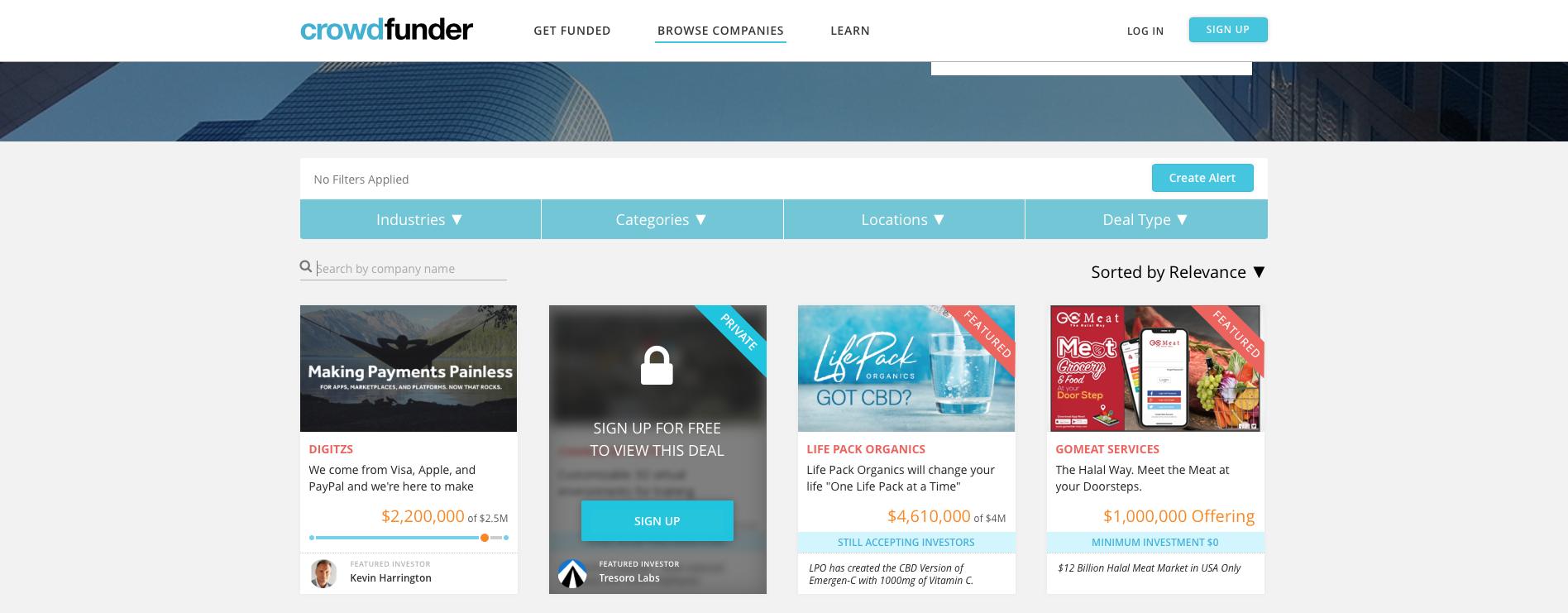
The Crowdfunder platform allows entrepreneurs to raise funds for their projects in exchange for a stake in their companies. Unlike all the other platforms mentioned above, Crowdfunder has a minimum investment amount that sometimes may reach tens of thousands of dollars.
Crowdfunder is a network of more than 130,000 entrepreneurs and investors that has helped its users make more than 100 deals for an average of $1.8 million each.
Challenges of creating a crowdfunding platform
Launching a crowdfunding platform entails overcoming a series of challenges. Let’s take a look at the challenges you’re most likely to face when starting your own crowdfunding platform.
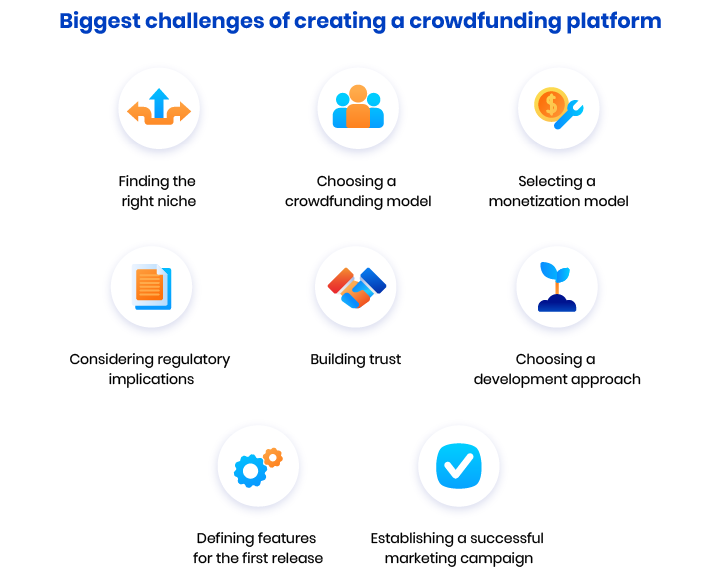
Finding the right niche
You need to choose the fundraising niche you want to fill. Choosing the right niche is important to make your marketing campaign straightforward and efficient. If the range of categories supported by your platform is too wide, it will be hard to target your marketing campaign to the right audience and find enough donors or investors. That’s why it’s best to narrow your focus to one or a handful of niches.
There are a huge variety of niches you can choose from. You can create a platform similar to Patreon to help musicians and artists raise money to launch new projects, record new songs, and shoot films.
Agriculture is another popular niche entrepreneurs need funds for. Examples of crowdfunding platforms for the agricultural sector are AgFunder and HarvestReturns.
One of the fastest-growing crowdfunding sectors is real estate. Companies that already work in this area of crowdfunding include PeerStreet and RealCrowd.
You can also help people fundraise for their projects in the space and science sectors. There are a huge number of people who need money for innovative space-related projects and scientific research. Platforms that have chosen this path include SpaceCrowdfund and Experiment.
The range of niches you can create a crowdfunding platform for is unlimited. Your platform may help fundraise for social or political nonprofit organizations, personal or medical issues, or anything else you can think of.
Choosing a crowdfunding model
In addition to a wide range of crowdfunding niches, there are various cooperation models you can choose for your crowdfunding platform. It’s essential that you choose a model that suits your niche and will attract both campaign creators and donors.
The most common crowdfunding models are:
- Loan-based or peer-to-peer lending — In this model, a platform plays the role of an intermediary between investors and creators. Borrowers get the money they need to implement their ideas, and later, investors get their money back with some interest.
- Donation-based — This is probably the simplest model, which involves donating to particular ideas or causes without expecting anything in return.
- Reward-based — On reward-based platforms, campaign creators get financial help for their projects in exchange for providing their products or services.
- Equity-based or investment-based — Campaign creators receive financial support from investors who, in turn, become part owners of the companies they support.
When choosing a cooperation model, consider the peculiarities of your platform and choose the model that best fits your platform’s mission. For instance, an equity-based model won’t be the best choice if you wish to create a crowdfunding platform for artists, as it would mean sharing copyrights with investors.
Selecting a monetization model
To make a crowdfunding platform not only a tool for promoting and implementing new ideas but also a source of revenue, you need to find a way to monetize it. Let’s walk through the most popular crowdfunding monetization models.
Success fee
In this monetization model, the platform receives a percentage from the sum an initiative or campaign collects. For instance, Indiegogo collects a 5% fee for raised funds.
Membership fee
With a membership or subscription model, the platform charges a monthly fee to run campaigns. For example, Fundable charges $179 per month to fundraise on the platform.
Loan processing fee
This type of monetization model is common for loan-based crowdfunding platforms. In the majority of cases, platforms that adopt such a model charge a percentage of the amount users borrow from lenders. For example, Landbay charges from 2% to 2.5% for each new loan and from 0.5% to 1% of the overall loan balance annually.
However, there are also platforms that charge both lenders and borrowers.
Portion of future sales
Instead of taking a percentage of the sum campaign creators collect on the platform, you can take a percentage of a campaign creator’s future revenue. PledgeMusic, for example, takes 15% from future sales of artists that fundraise on the platform.
Promotions and advertising
Another way to monetize your crowdfunding platform is to implement advertising or let users promote their campaigns for a fee. The Causes platform allows nonprofits to start campaigns and support initiatives for free and gets revenue from advertising.
Your choice of monetization model will depend on your niche and the cooperation model you’ve chosen for your platform. Try to select a model that will be beneficial for both you and your platform users.
Considering regulatory implications
As with any other business, crowdfunding platforms need to comply with certain laws and regulations. Crowdfunding business owners need to plan and conduct protection measures to ensure the security of their platforms and compliance with Know Your Customer (KYC) standard and Anti-Money Laundering (AML) laws.
KYC is a set of guidelines business owners should follow to verify the identity of their clients (especially investors and donors) to ensure they are who they claim to be. These guidelines aim to establish a customer’s identity, assess money laundering risks, and identify if the source of a customer’s funds is legal. KYC is part of AML procedures and standards.
AML laws, regulations, and procedures aim to prevent criminals from hiding money that was obtained illegally. AML regulations require financial institutions to verify the origin of large sums of money and to monitor and report on suspicious activity of their clients.
In addition to following the principles mentioned above, you need to ensure the security of sensitive data related to your clients’ bank accounts and credit cards to prevent it from being accessed by a third party.
Building trust
When donating to an initiative or creative idea, backers want to be sure their money will go where it’s supposed to. Crowdfunding platforms should make every effort to prevent fraud and protect donors’ funds.
Kickstarter, Indiegogo, and GoFundMe have separate teams to verify identities, monitor suspicious activity, and suspend campaigns that fail to meet platform requirements.
To make people trust you, you need to build a solid security policy and procedures according to which you will detect fraudulent campaigns, spot suspicious accounts and activity, and protect funds of investors and donors.
Choosing a development approach
Before starting platform development, you need to decide on a development approach. You can build your platform using an open source CMS, a white label solution, or custom development. Let’s take a look at each of these options.
Open source CMS
Open source applications like WordPress allow you to create a crowdfunding platform with the help of templates and plugins. Thus, choosing this path allows you to avoid creating everything from scratch.
The majority of open source CMSs are free. However, if you need to extend the functionality of your platform in any way, you’ll need to use paid themes and plugins. Unfortunately, some functionality may still be impossible to implement without modifying code. In this case, you’ll need to find a developer that can help you implement what you want. Another disadvantage of using a CMS is that CMS-based platforms are more prone to hacking than custom and white label platforms.
White label solution
White label solutions are built using ready-made modules that implement crowdfunding marketplace functionality. Using these modules, a vendor can quickly create a platform for you, brand it, and launch it to the market.
A white label solution allows you to significantly shorten the time to market for your product in comparison to custom development, as it requires less effort on your end.
When buying a white label product, you may get a platform that’s less flexible than a custom platform. Thus, there’s a chance that a white label platform may not suit the unique needs of your business, and adding specific features will require code modifications. Moreover, this approach doesn’t give you any control over the technology stack.
Custom development
Creating a custom crowdfunding platform means hiring a developer or a team of developers to create a solution that will satisfy your business needs.
This approach allows you to decide what technology stack to use and what features to implement. It also allows you to reflect your company’s unique identity in your platform’s design. Moreover, as development is conducted in stages and a product usually has several releases, you’ll be able to modify and improve the product according to your end users’ ever-changing needs and expectations.
However, such an approach to creating a crowdfunding platform requires more resources compared to open source and white label solutions.
Defining features for the first release
To ensure there’s a market for your crowdfunding platform, you first need to launch a minimum viable product (MVP) instead of a full-fledged product. This will allow you to test your business idea fast and with minimal resources.
An MVP is a version of a product that has enough features to engage users, satisfy them, and elicit their feedback. To decide what features to implement in your MVP, you need to define the list of features of your platform, prioritize featuser, and implement only those that are essential.
Establishing a successful marketing campaign
A marketing campaign is key to your crowdfunding platform’s success. To make your campaign as efficient as possible, you need to complete the following steps:
- Conduct thorough market research to identify if there’s a market need for your platform and whether a platform with the features you wish to implement already exists.
- Define your target audience and create user personas to understand vital problems your audience is striving to solve.
- Set campaign goals. Identify measurable KPIs that will help you assess the success of your marketing campaign.
- Create content that will address the problems of your target audience. Content may include blog articles, emails, and landing pages.
- Analyze the strong and weak sides of your marketing campaign, assess its efficiency, and make adjustments if needed. In addition, you may use A/B testing to validate various types of content for different personas.
Tips on how to create a successful crowdfunding platform
The success of a crowdfunding platform is about more than meeting regulatory requirements and using the right technologies and marketing tools. Here, we provide you with a few tips on how to build a successful crowdfunding business and make your platform attractive for users.
Start with a measurable business goal
The first thing you need to do before starting to develop your own crowdfunding platform is to set clear and realistic goals. To visualize the final product better, you and your team should set the criteria according to which you’ll assess your progress. This may include a list of features to be implemented, the date of the final release, and the number of campaigns created on the platform during the first several months. These criteria will help your team to stay motivated and meet deadlines.
Reconsider perks and gifts for donors
Researchers from Yale University found that people who receive a gift actually donate less. The reason is that when donating, people act on altruistic impulses. But when they’re offered a gift in exchange for a donation, the transaction acquires a commercial character. Donors interpret such donations as an ordinary monetary exchange, and it discourages them from giving.
Thus, when implementing gifts and bonuses, try not to discourage backers from donating.
Create a community
Turning your crowdfunding platform into a community can encourage backers to donate more and help campaign creators meet their goals faster. Here are several steps you can take to create your own crowdfunding community:
- Define your mission — People tend to join communities that share their views and beliefs. Clarify your mission and let your users know what you’re striving for. This will encourage like-minded people to join your community and pursue common goals.
- Share success stories — Motivate your users with stories of those who have reached their goals and brought their ideas to life.
- Facilitate communication — Let users communicate with each other by implementing comments on campaigns so users can ask questions and get answers.
Conclusion
It may seem that starting your own crowdfunding platform involves too many pitfalls and challenges. However, with the proper approach and the right team, even the hardest path becomes an exciting adventure.
FAQ
-
When starting a crowdfunding platform, you’re most likely to face the following challenges:
- Finding the right niche
- Choosing a crowdfunding model
- Selecting a monetization model
- Meeting regulatory requirements
- Building trust
- Choosing a development approach
- Defining features for the first release
- Establishing a successful marketing campaign
-
There are several monetization models you can choose from:
- Success fee
- Membership fee
- Loan processing fee
- Portion of future sales
- Promotions and advertising
-
You can develop your crowdfunding platform using:
- an open source CMS
- a white label solution
- custom software development services
If you’re looking for a development team to help you create a successful custom crowdfunding platform, contact RubyGarage and we’ll provide you with the service you need.






